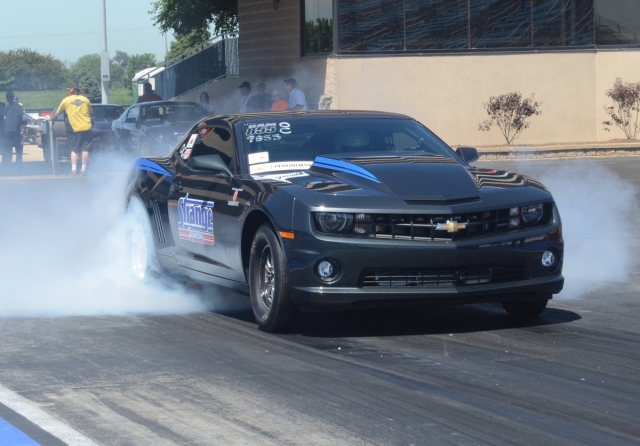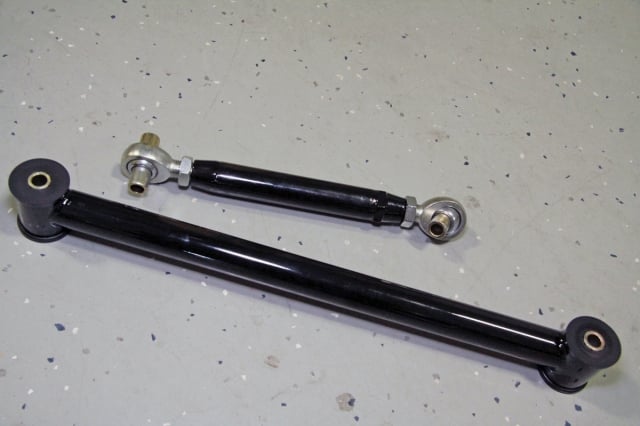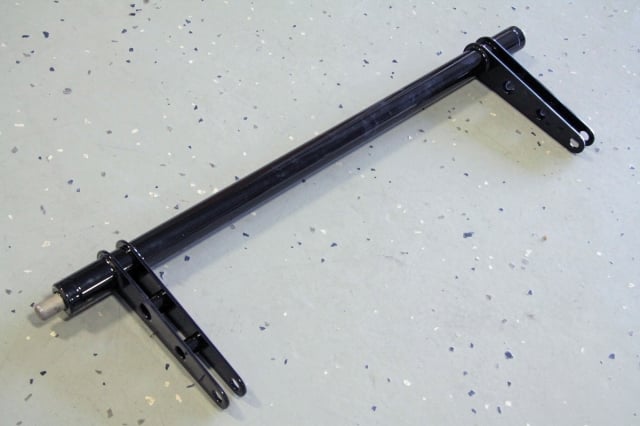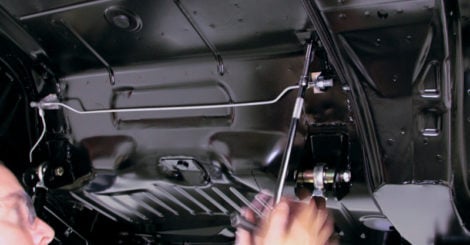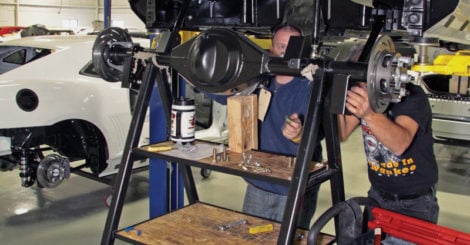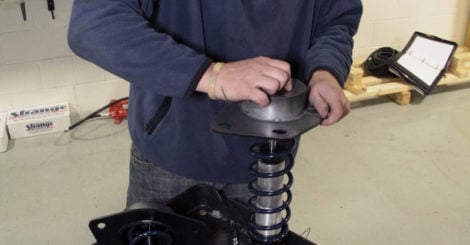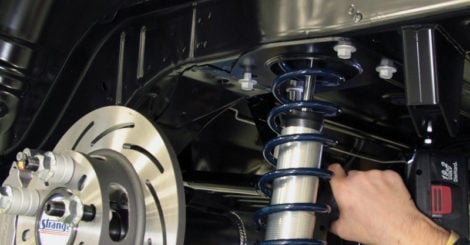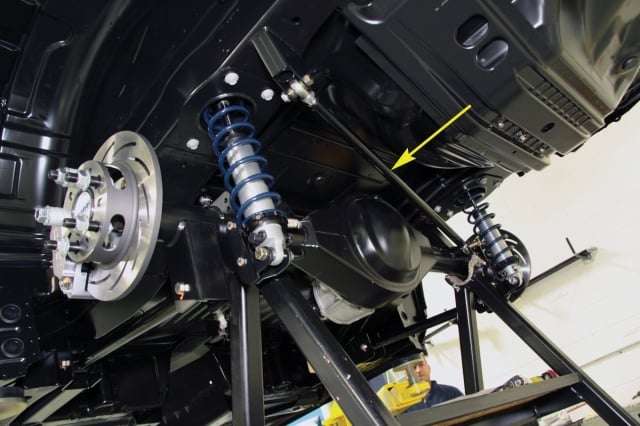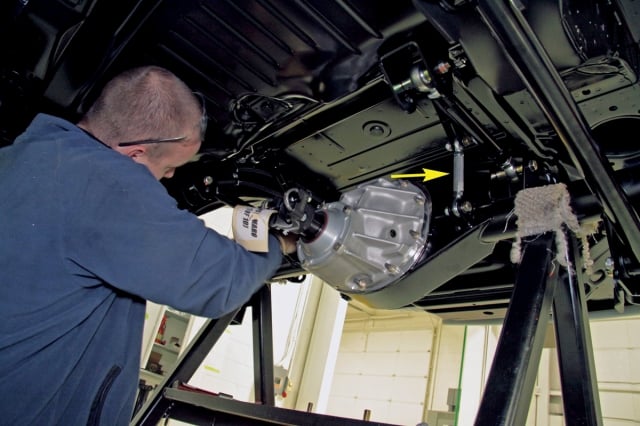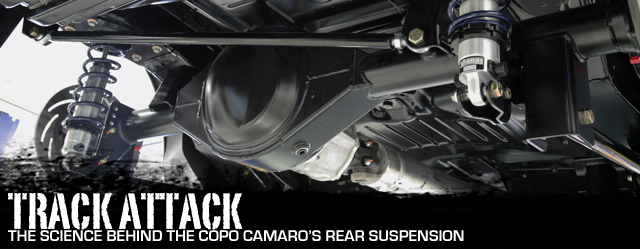 [1]The original Chevrolet COPO Camaro program came into existence in the 1969 model year – quite coincidentally, the same year as the most sought-after Camaro bodystyle in the eyes of enthusiasts.
[1]The original Chevrolet COPO Camaro program came into existence in the 1969 model year – quite coincidentally, the same year as the most sought-after Camaro bodystyle in the eyes of enthusiasts.
Thanks to an internal Chevrolet corporate edict, the company was banned from installing engines larger than 400 cubic inches into any of their cars that year, but dealers like Don Yenko were installing 427’s already. The Central Office Production Order process typically used for fleet vehicles like taxis made an end-run around the corporate engine-limit ban, and the COPO Camaro was born.
COPO 9561 allowed dealers like Yenko to order the L72 big-block engine, and somewhere around 1,000 Camaros were produced with this option that made 425 horsepower. But it was COPO 9560 that made all the noise – thanks to the exploits of NHRA racer Dick Harrell. An all-aluminum 427-cube big-block called the ZL-1 was front-and-center in the engine bay; the COPO Camaro with this option was designed to dominate NHRA Super Stock drag racing. The hand-built ZL-1 engine was capable of over 500 horsepower with mild tuning changes from as-delivered form, and set the stage for today’s run of modern COPO cars [2].
Today’s COPO Camaro uses current technology housed in a modern chassis and has been designed by Chevrolet to – yep, you guessed it – dominate NHRA Stock and Super Stock Eliminator classes from the outset. But in order to be legal, the cars needed to adhere to a particular set of rules that the other “factory racecars” such as the Mustang Cobra Jet and Dodge Drag Pak Challenger also abide by.
The decision was made internally to install a solid rear axle to better handle the rigors of drag racing, as the production-level fifth-gen Camaro uses an independent rear suspension. It required some crafty engineering on the part of Chevrolet Performance [4] and their chosen rearend provider, none other than legendary motorsports company Strange Engineering [5]. The COPO’s suspension was designed with the help of noted drag-racing chassis builder Mike Pustelny of MPR Race Cars [6]. Read on for the science behind the build as we go all-in to disclose the details.
Engineering The Suspension
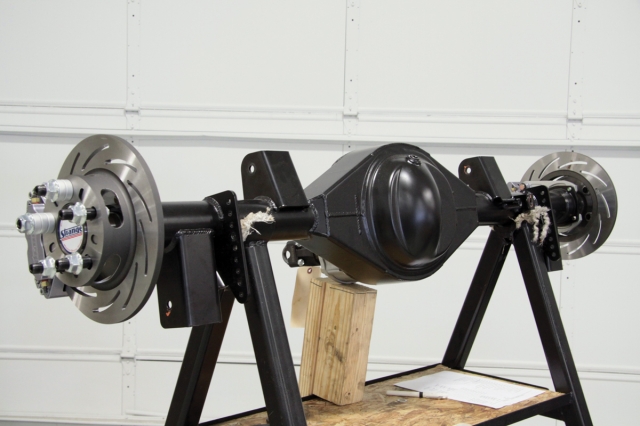 [7]
[7]The Strange Engineering nine-inch Ford housing is packed full with a lightweight spool and 35-spline axles, along with their Pro/Race steel rear brakes. Suspension brackets to fit the Camaro body are installed at the Strange factory before powdercoating.
The factory independent suspension presented a number of challenges for the Chevrolet Performance engineers when developing the COPO package, and to that end they selected Pustelny to do the development work on the chassis to allow the straight-axle housing to fit properly under the car.
“We contracted MPR Race Cars, and Mike built the suspension along the lines of what NHRA approved,” says Chevrolet Performance’s Roger Allen. “We provided MPR with the design direction, and then MPR fabricated the parts to put everything in place. The overall geometry and pickup points had to be as specified by NHRA. They basically gave us suspension pickup points from the Strange axle and said ‘Here’s where the Dodge and Ford pickup points are – yours have to be in the same place.’”
MPR had to reverse-engineer the pickup points from the given locations to fit specifically in the Camaro chassis, which was a challenge given the current independent-rear suspension design and the fact that the platform was never designed to have the solid axle placed underneath. As he had completed the same type of work for Dodge on the Drag Pak Stock Eliminator program, he had a good idea of where to start.
Left - The COPO Camaro suspension design centers around a set of fixed-length lower control arms and adjustable uppers so that pinion angle can be set for maximum traction. Right - The anti-roll bar is constructed from 1 1/4-inch 4130 chromoly tube and has six-inch arms to connect the links to the rearend.
“The suspension was developed from what we know will work, what we know the NHRA will accept, and what we know will be safe,” explains Pustelny. “Once NHRA looked it over and gave us approval for the design, I drove the test car for the first year. Even the first time out, the car went down the track like it was on a string. It’s no revelation that we could make some changes to make the car work better, but one of the criteria for Stock Eliminator is that you must have a fixed lower control arm, and the brackets on the chassis and rear axle housing cannot have multiple holes – there’s only one position where the bars can be located.”
The Suspension Parts
With the restrictions placed upon the design by NHRA, Chevrolet Performance had a box to work within, and the end result is a four-bar, upper- and lower-control arm design that uses a Panhard bar for lateral location and an antiroll bar for dragstrip performance.
The suspension was developed from what we know will work, what we know the NHRA will accept, and what we know will be safe. – Mike Pustelny, MPR Race Cars
The nonadjustable lower bars are constructed from 20 inch-long, TIG-welded 1 3/4-inch .083-wall 4130 chromoly that uses a urethane bushing at each end. Upper control arms are permitted to be adjustable, and to that end MPR developed 1 1/4-inch, .095-wall 4130 chromoly that has a left/right hand tube adapter welded in for pinion-angle adjustment purposes. There is a 3/4-inch x 3/4-inch chromoly rod end at each end of the upper bars. Suspension attachment bolts are 1/2-inch on upper and lower bars – the lower bars use a sleeve within the bushing to achieve this dimension, and the upper bars have machined spacers that sit within the rod end.
The antiroll bar uses an interesting design – a 5/8-inch spherical bearing at each end of the bar is threaded into tubes that are mounted in the chassis. The bar itself is 1 1/4-inch .095-wall 4130 hollow chromoly tube with six-inch arms welded at each end that use aluminum/rod-end links to connect to the rearend housing.
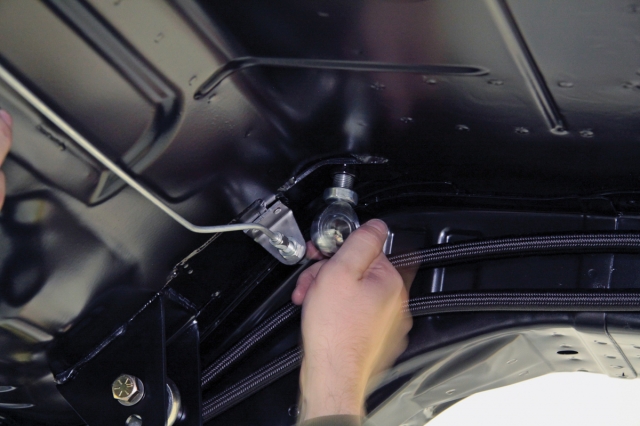 [10]
[10]Chevrolet Performance engineered the spherical rod-ends for the antiroll bar to mount topside to the chassis and capture each end of the bar, rather than many traditional bars that mount to the framerails at each end.
The Axle Parts
Other Strange COPO Parts
Strange Engineering didn’t just supply custom-built axle assemblies for the COPO program; their involvement went much further into other areas of the car’s development.
“We also supplied the front and rear brakes along with the dampers. The front coil-over struts are double-adjustable, as are the rear shocks. The brakes are based on our proven Pro Race units and modified for the COPO application,” says Cascio.
It’s no surprise that Strange Engineering was tapped to provide the parts for the COPO Camaro as well – they also supply the other two members of the Big 3 with rearend assemblies for their own pony cars. These factory race cars have been battling it out on the 1320 – with Strange gear – for the last few seasons in Stock and Super Stock Eliminator.
Once Pustelny had the basics of the platform roughed in, he provided the dimensions of the housing, control arm brackets, and anti-roll bar and Panhard bar mounting points to the fine folks at Strange.
From there, they were off to the races to create the bolt-in housing, gearsets, axles, and other components required to create a rearend that would stand up to Stock Eliminator abuse.
Per JC Cascio of Strange Engineering, “We started with our standard nine-inch housing and used the pickup points developed by MPR to fit the solid axle in the car. The brackets are all welded onto the housings here in a fixture that we have on-site to ensure the proper fitment when the housing gets to Michigan.”
The steel housing is supplied with one of Strange’s Lightweight aluminum gearcases that’s been fully equipped with a 35-spline lightweight spool. Gear ratios are dependent upon the engine combination selected, and a forged-aluminum pinion support is also standard, as is a heavy-duty 1350-series chromoly pinion yoke.
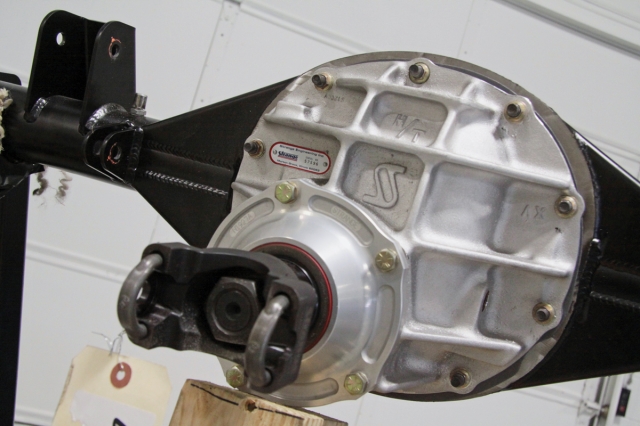 [12]
[12]Heavy-duty parts are used throughout the construction of the rearend, including thick-wall three-inch tubes and Strange’s Lightweight aluminum center section. A forged pinion support and 1350 yoke is installed on the front of the pinion.
Strange’s Pro gearsets are constructed from 9310 steel and are specifically designed to handle the rigors of drag-race abuse. The high-impact shock loads seen by a racing application necessitate the use of the Pro gearsets in this application. 35-spline Hy-Tuf axles are installed in the housing along with axle bearings and 5/8-inch wheel studs.
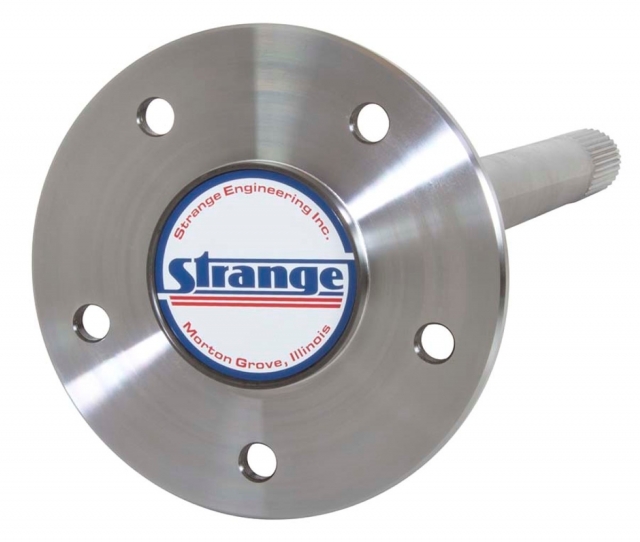 [13]
[13]Strange Engineering’s 35-spline axles are forged from proven Hy-Tuf material and are used throughout drag racing in all types of applications.
The Hy-Tuf ultra-strength alloy material was originally developed for military aircraft landing gear. It’s formulated from low-carbon, high-manganese, high-nickel, high-molybdenum steel and is through-hardened to provide exceptionally high tensile strength of 240,000 PSI while remaining flexible enough to handle other loads placed upon it by racing endeavors.
Strange’s Pro Race rear brake kit is also installed on the housing at the Strange facility. It includes aluminum calipers and solid slotted-surface 11.25-inch brake rotors, along with brake pads and billet caliper mounts.
The four-piston calipers use stainless-steel pistons, and are internally ported with an O-ring around the piston to assist in piston retraction when the pedal is released.
Left - Prior to axle installation, the Chevrolet Performance technicians chase the bolt holes in the chassis to clear out any residual powdercoat. Left Middle - With the help of this roll-around cart, the rearend is placed under the car. Note the control arms already in place at this time. Right Middle - Chevrolet Performance engineered an upper shock mount that places the coilover assembly right into the factory coil spring pocket. Right - Strange's double-adjustable rear shocks are used to provide the ultimate in chassis control and adjustment.
On The Assembly Line
To make these pieces talk to one another in the chassis, the Chevrolet Performance team tasked with creating the COPO cars needed to follow the blueprint laid down by the COPO proof-of-concept car. The CP team removes all of the independent rear suspension mounts and brackets, save for the upper spring perch, then fabricates and welds in the pickup points for the new suspension.
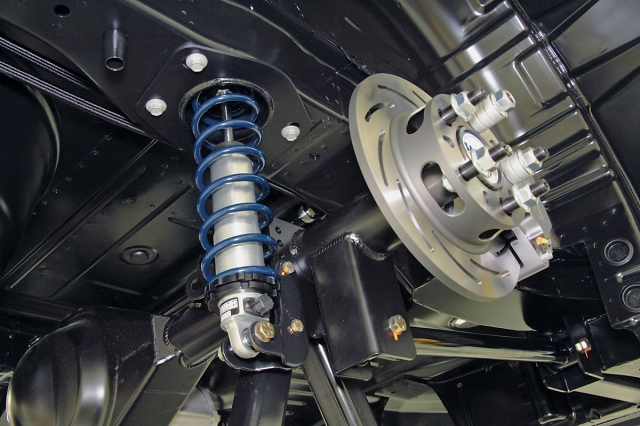 [18]
[18]A closer look at the upper spring mount bolted into the chassis, along with the lower control arm location and Strange Engineering Pro Race brake assembly.
“We took the bodies-in-white from Oshawa, which is where they build the Camaro production cars, and duplicated what Mike had done with the prototype proof-of-concept build. Each of the pickup points had to be integrated with the rollcage and the body structure,” says Allen.
In order to do that, Pustelny developed a spring perch design that bolts into the car in the same location where the factory coil-spring mount would be in a production car. He also fabricated templates that the COPO production team could use during the build process to to ensure each pickup point was located in the exact same place.
The templates were created during the initial build process for the suspension design to assist Chevrolet Performance in building the cars on the assembly line. As MPR Race Cars also supplied the rollcages for the COPO cars, each component was designed to work together right from the outset.
“On the production COPO cars, the key was that once Mike had the proof of concept done, we were able to create the templates for placement of the pickup points relative to some standard fixture tooling points on the body-in-white. We place the templates, cut out the hole and fit the new pieces right in, and it looks OEM when it’s complete. If you didn’t know, you’d think that’s just how it was,” says Allen.
Left - The Panhard bar locates the rearend side-to-side within the chassis. Right - Arrow points to the antiroll bar links. Mounts for these are also welded to the rearend housing prior to powdercoating.
I Want This!
If you have a fifth-generation Camaro and plan on drag racing it, you too can have the same suspension design that exists in the COPO package, including the axle and all related hardware. It can be fabricated into your rollcage design by your chassis builder.
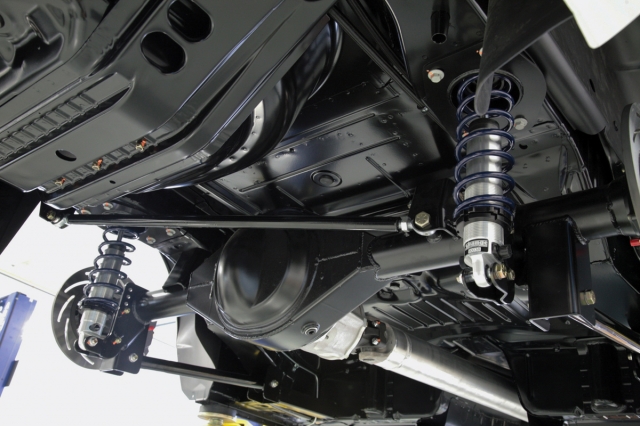 [21]
[21]A final view of the completed Strange Engineering axle assembly, brakes, and COPO suspension parts mounted in the car. As Allen said during our conversation, if we didn’t know any better, we’d think these were factory parts. Oh..wait..they are!
The suspension parts are homologated by NHRA thanks to the inclusion of this part number in the Chevrolet Performance catalog. The rear axle kit carries Chevrolet Performance Part Number 22950665, and needs to be ordered directly through COPO Parts Direct [22]. It can be ordered in various stages of completion, from an install kit that includes all of the mounting brackets that a chassis shop could fabricate the rest of the suspension to a complete assembly including control arms, brakes, Panhard bar, and antiroll bar. Pustelny notes that this is not a kit for the novice; instead, he recommended that an experienced builder tackle the job.
The COPO Camaro is a true factory-built race car, and the development work done by aftermarket partners like Strange Engineering and MPR Race Cars has been invaluable throughout the development and build processes.
